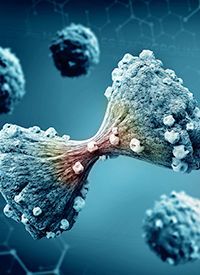Adjuvant Chemotherapy After Nephroureterectomy Offers DFS Benefit in Upper Tract Urothelial Cancer
Patients with upper tract urothelial cancer who received adjuvant chemotherapy after nephroureterectomy experienced extended DFS vs those who received surveillance.

Adjuvant chemotherapy following nephroureterectomy led to a disease-free survival (DFS) benefit in patients with upper tract urothelial cancer (UTUC), according to findings from the phase 3 POUT trial (NCT01993979) published in the Journal of Clinical Oncology.1
At a median follow-up of 65 months (IQR, 60-84), final results from the study demonstrated that patients treated with platinum-basedchemotherapy following radical nephroureterectomy (n = 132) experienced a 5-year DFS rate of 62% compared with 45% among those who received surveillance after surgery (n = 129; HR, 0.55; 95% CI, 0.38-0.80; P = .001). Moreover, the 5-year overall survival (OS) rates were 66% vs 57%, respectively (HR, 0.68; 95% CI, 0.46-1.00; P = .049).
“Although OS was not the primary outcome measure, the updated results add further support for the use of adjuvant chemotherapy in patients with UTUC, suggesting long-term benefits,” study authors noted.
The multicenter, open-label POUT trial enrolled patients with muscle-invasive or lymph node–positive, nonmetastatic UTUC. Eligible patients needed to be at least 18 years old, have a WHO performance status of 1 or less, have a satisfactory hematological profile, be eligible for adjuvant chemotherapy, and be available for long-term follow-up.2
After radical nephroureterectomy, patients were randomly assigned 1:1 to receive either platinum-based adjuvant chemotherapy or surveillance. Chemotherapy consisted of four 21-day cycles of gemcitabine 1000 mg/m2 daily on days 1 and 8 with cisplatin 70 mg/m2 or carboplatin AUC 4.5 or 5 on day 1, if the patient’s glomerular filtration rate was 30 to 49 mL/min.1
The primary end point was DFS. Secondary end points included OS, metastasis-free survival (MFS), incidence of bladder second primary tumors, incidence of contralateral primary tumors, safety, and quality of life (QOL).2
Earlier findings from the trial, which were published in The Lancet with median follow-up of 30.3 months (IQR, 18.0-47.5), demonstrated that the median DFS had not been reached in the adjuvant chemotherapy arm compared with 29.8 months in the surveillance arm (HR, 0.45; 95% CI, 0.30-0.68; P = .0001). The estimated 3-year DFS rates were 71% (95% CI, 61%-78%) vs 46% (95% CI, 36%-56%), respectively.
Investigators also showed a reduction in the the risk of metastasis or death by 52% with adjuvant chemotherapy (HR, 0.48; 95% CI, 0.31-0.74; P = .0007), with 3-year event-free rates of 71% and 53% in the chemotherapy and surveillance arms, respectively.3
The baseline characteristics were well balanced between the 2 arms; the median age was 66 years (range, 43-88) vs 69 years (range, 36-85) in the surveillance and chemotherapy arms, respectively. Most patients in both arms were male (64.3% vs 71%), had a nodal involvement of N0 (91.5% vs 90.1%), had negative microscopic surgical margins (89.2% vs 87%), and had T3 stage disease (68.2% vs 63.4%). Primary tumor locations in the surveillance arm consisted of the ureter (n = 42), renal pelvis (n = 45), both (n = 41), and unknown (n = 1); in the chemotherapy arm, 47, 47, 37, and 0 patients had these tumor locations, respectively.1
Additional findings from the final analysis revealed the restricted mean survival time (RMST) for DFS was 72 months in the chemotherapy arm compared with 54 months in the surveillance arm, representing an 18-month improvement in the chemotherapy arm (95% CI, 6-30; P = .003). The difference in RMST for MFS was also improved by 18 months (95% CI, 6-29; P = .002) with chemotherapy vs surveillance.
Subgroup analysis findings showed that a DFS benefit was achieved with chemotherapy over surveillance in nearly all subgroups, with the most pronounced benefit being observed in those with positive microscopic margin status (HR, 0.37; 95% CI, 0.13-1.05) and those with a primary tumor location of both the ureter and the renal pelvis (HR, 0.46; 95% CI, 0.23-0.94). Chemotherapy provided an OS benefit vs surveillance in all the key subgroups examined, with the greatest benefit being observed in patients for whom investigators planned to administer gemcitabine and cisplatin (HR, 0.57; 95% CI, 0.33-0.97) and those with negative microscopic margin status (HR, 0.61; 95% CI, 0.40-0.94).
In terms of safety, toxicity reported between 6 and 24 months postrandomization was 16.7% in both arms combined according to the Common Terminology Criteria for Adverse Events. No significant differences in QOL were reported.
“The POUT primary analysis showed acceptable levels of acute toxicity with chemotherapy, in line with previous reports. In the current analysis, data on both clinician-reported toxicity and patient-reported QOL provide reassurance that there are no important long-term adverse impacts, which might offset the benefits. Systemic therapy on relapse was less frequent in those who received adjuvant chemotherapy than those in the surveillance group. In summary, updated outcomes from the POUT trial add further support to the value of adjuvant systemic gemcitabine [and] platinum combination chemotherapy after nephroureterectomy for UTUC,” study authors wrote in conclusion.
References
- Birtle AJ, Jones R, Chester J, et al. Improved disease-free survival with adjuvant chemotherapy after nephroureterectomy for upper tract urothelial cancer: final results of the POUT trial. J Clin Oncol. Published online February 13, 2024. doi:10.1200/JCO.23.01659
- A phase III randomised trial of peri-operative chemotherapy versus sUrveillance in upper tract urothelial cancer (POUT) (POUT). ClinicalTrials.gov. Updated May 4, 2020. Accessed March 5, 2024. https://www.clinicaltrials.gov/study/NCT01993979
- Birtle A, Johnson M, Chester J, et al. Adjuvant chemotherapy in upper tract urothelial carcinoma (the POUT trial): a phase 3, open-label, randomised controlled trial. Lancet. 2020;395(10232):1268-1277. doi:10.1016/ S0140-6736(20)30415-3



